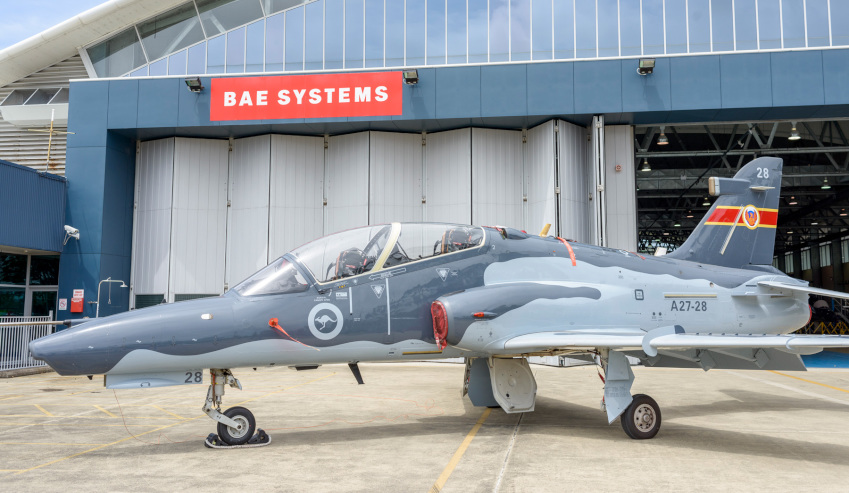The first cohort from the Royal Australian Air Force’s 79 Squadron has commenced training with the latest digital standard of Hawk advanced jet trainers, having accepted the first upgraded aircraft from BAE Systems.
To continue reading the rest of this article, please log in.
Create free account to get unlimited news articles and more!
Each upgraded Hawk provides new training capabilities, including simulated radar, electronic warfare, digital mapping, ground proximity warning system and traffic collision avoidance. The upgrade also includes the replacement of two legacy synthetic training devices with three full mission simulators provided by CAE.
BAE Systems said the upgrade of the Australian Hawk fleet is delivering an enhanced training capability to prepare pilots for life in the cockpit of fast jet aircraft including F/A-18 A/B Classic Hornets, F/A-18F Super Hornets, EA-18G Growlers and, when introduced into service in late 2018, the F-35A Lightning II Joint Strike Fighters.
The initial operating capability for the Lead-In Fighter Capability Assurance Program (LIFCAP) was recognised at a ceremony at RAAF Base Williamtown.
BAE Systems’ engineering teams in Australia and the UK, together with CAE and Cubic Defense Applications Inc, worked closely with the Commonwealth to deliver this enhanced capability. A joint team of BAE Systems and RAAF technicians has already completed the upgrade of 12 of the 33 fleet of aircraft. Once modified, all 33 aircraft will be almost identical to the Hawk Advanced Jet Trainer (AJT) of the UK’s Royal Air Force.
BAE Systems Australia chief executive Glynn Phillips said, "The upgraded BAE Systems Hawk aircraft provides the RAAF with a leading edge capability and, coupled with the CAE full mission simulators, delivers a highly impressive lead-in fighter training system (LIFTS) that will ensure Hawk retains its effectiveness into the next decade and beyond.
"The upgrade brings the RAAF Hawk up to the same platform capability as the most modern Hawk aircraft around the globe; allowing for future shared development and potentially shared cost, across multiple users."
Acting Commander Air Combat Group, Group Captain Robert Denney said, "The initial operating capability for the represented an important milestone in developing Air Combat capability and was essential for providing the quality and quantity of pilots and air combat officers for the Air Force.
"The LIFCAP introduces a major avionics upgrade to the Hawk 127 Lead-In Fighter, three advanced full mission simulators and operational support systems which will ensure that the lead-in fighter training system is capable of producing sufficient, suitably trained aircrew to operate F/A-18F Super Hornet, EA-18G Growler and F-35A Joint Strike Fighter aircraft.
"A mid-life upgrade to the Hawk was necessary to ensure its continued viability, to decrease risk to operational conversion output and to provide the LIFTS with adaptability to support the training requirements associated with the new platforms."
The upgrade of the aircraft has included full ground testing and developmental flight clearance by a joint RAAF/BAE Systems team.
The Hawk aircraft fleet embodiment upgrade started in 2014 at BAE Systems Australia at its fast jet facility at Williamtown, NSW, and the fleet upgrade will be completed by early 2019.
BAE Systems Australia has been maintaining and upgrading fixed wing and rotary aircraft under performance-based contracts with the RAAF for more than 16 years.
Australia bought 33 Hawk Lead-In Fighter aircraft in the 1990s. Most of the aircraft were assembled at Williamtown.
The aircraft are operated by 76 Squadron at Williamtown and by 79 Squadron at RAAF Base Pearce near Perth.
The Hawk Mark 127 Lead-In Fighter is a tandem, two-seat jet aircraft. It is used to prepare the RAAF’s fast jet aircrew for operational conversion to the F/A-18 Hornet, F/A-18 Super Hornet and, ultimately, the F-35 Joint Strike Fighter.
Hawk is a proven military trainer with more than 1,000 aircraft either in service or on order with air forces across the globe.
The technology at the heart of Hawk has seen the aircraft enhance customer training pipelines for the front line fighter pilots of the future.
Students are put at the controls of the latest radar, weapons systems and defensive aids simulation technology, providing a unique ‘brain training’ environment to prepare them for life in next generation combat aircraft.

 Login
Login







